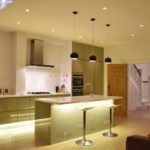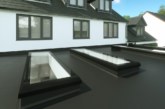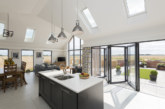Implementing smart lighting thoughtfully and properly is key to ensuring it offers true benefits. Gresh Braglewicz, Director at Ember Lighting, looks at how housebuilders and property developers can successfully deliver a smart lighting scheme in new properties.
The difference that lighting can make to a home should not be underestimated. While it does of course have a functional element, an increasing number of people are demanding lighting systems that add to the look, feel and atmosphere within their home. From early morning lights to help us wake up and function, through to a late-night glow to aid relaxation before bed, lighting supports our activities throughout the day. Smart technology can assist this in many ways, yet it must be well-thought out, and from the offset of a project, to ensure it really delivers what it is supposed to. So what are the different elements to consider?
Control systems should ultimately make a home’s lighting easier to operate, not more complicated. They should not require excessive amount of thought or effort. For example, a control system that requires 6 different dimmers in a room just to get the desired effect is not fit for purpose. It should be as simple as pressing a button.
Ember Lighting’s advice would be to think about how a room will be used, and that will tell you how many buttons you need. For example, a dining room is a place used for entertaining and eating. Therefore, most homes will need a brighter setting for family dinners, and a more ambient setting for entertaining guests or romantic dinners. So using this rule, that would equate to two buttons.
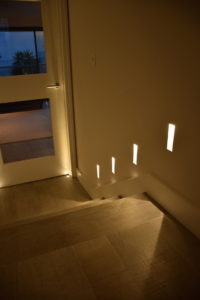 This also links to the issue of maintenance, and some systems will inevitably require more upkeep than others. It is ideal to choose a system that can be maintained by an electrician or even the homeowner themselves. If a more sophisticated option is selected, then housebuilders could consider offering a maintenance contract. This will not only give the homeowner reassurance that the system has longevity, it provides an additional revenue stream for housebuilders.
This also links to the issue of maintenance, and some systems will inevitably require more upkeep than others. It is ideal to choose a system that can be maintained by an electrician or even the homeowner themselves. If a more sophisticated option is selected, then housebuilders could consider offering a maintenance contract. This will not only give the homeowner reassurance that the system has longevity, it provides an additional revenue stream for housebuilders.
Set up is essential for all control systems. Where projects fail, it is often because they have not been commissioned properly. Housebuilders and developers should allow for at least two visits for a commissioning engineer – one to complete the basic setup and testing, and one for them to set the actual scenes or moods in the room. If possible, this should be done with the client there.
A third scheduled visit could be a value-added service that sets apart a housebuilder. This visit should be carried out once the homeowner has been living in the property for several months, as it is an opportunity to make any adjustments they would like and address and potential issues.
Wiring and wireless
Newer control systems currently require far less wiring, with wireless switches. This is great news for housebuilders and developers as it reduces labour, and makes it quicker and easier to install the smart lighting system.
While this is a clear benefit and means the timing of the lighting installation in the project schedule can be a bit more flexible, smart lighting should still be considered very early on. While the wiring may be easier and therefore create less pressure on other elements of the build, if it is not planned at the design stage these cost and efficiency savings will be lost.
Motion sensors
Motion sensors, sometimes known as PIR sensors, provide a small amount of automation. They are an excellent addition to bathrooms to control a small, low-level night light or in hallways. Some control systems will allow you to have different scenes for different times of the day, for instance, in the daytime the main hallway lights will turn on brightly, but in the evening, they will only come on at 5%.
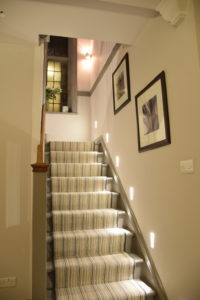 Ensure compatibility and longevity
Ensure compatibility and longevity
With the growing demand for smart lighting, there has naturally been an increase in the number of systems now available on the market. Solutions include Bluetooth, Wifi, KNX, and Power over IP, to name just a handful. While choice is naturally a good thing, with it comes complications around compatibility. The selected control system needs to be able to fully integrate and work with all of the lighting that it will control.
The matter becomes even more complicated when you consider the different types of luminaires that are now used throughout a home. But this is the key point – to choose the lighting first, and then the control second, therefore ensuring its compatibility. While the smart technology is an important element of the overall scheme, it will only be as good as the lights it controls. These issues over compatibility are perfect examples of where a lighting specialist may be needed to offer expert consultancy, and sourcing of solutions.
Furthermore, the longevity of a system is equally as important. An ideal smart system could last for 20-30 years; after all, replacing it could be costly in both the upgrade and any decorative work to compensate for it. Choosing a system which the homeowner can adjust themselves, rather than relying on a programmer, is also a key benefit, since finding the same person to make adjustments 10 years on can be complex. If a programmer is required, make sure you choose a system which does not lock you into one programmer, but allows any qualified person make adjustments.
Lighting controls are amazing, but only if they are set up correctly to ensure they deliver the desired results, with minimum input from the user. While it may seem complicated, by following these points smart lighting can become a great feature of your new build or developed property.

